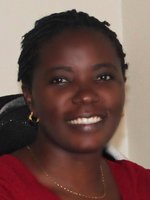Reducing micronutrient deficiencies with vitamin A-rich bananas in rural Eastern Africa

Beatrice Ekesa, post-doctoral fellow, Bioversity International, is working in Eastern Africa where banana forms an important part of diets. She explains her research on using banana diversity to help reduce micronutrient deficiencies.
Beatrice Ekesa is a post-doctoral research fellow at Bioversity International, working on Diet Diversity for Nutrition and Health. Beatrice currently leads two research initiatives in sub-Saharan Africa looking at how using agricultural diversity in diets can help prevent micronutrient deficiencies, particularly in women and children. Beatrice focuses her work in populations where banana forms an important part of the diet. She recently took some time out of her busy schedule to explain more about her work.
Q: Can you explain more about the work Bioversity International is doing on diet diversity for improved nutrition and health?
Global malnutrition is one of the main challenges affecting many people around the world today. We are seeing population growth coincide with increasing health concerns, an increase in the numbers of stunted, underweight, micronutrient deficient and overweight people. At Bioversity International, we are looking at how diversity within diets can help promote good nutrition and prevent some of these problems. We are also aware of the cultural importance of food to people, so we work alongside communities to find solutions that tackle deficiencies, and help make their diets more sustainable, affordable, and accessible all year around and do so in a culturally acceptable manner.
Q: Can you tell us more about your work on banana diversity in Eastern Africa?
I am working in Eastern Africa, specifically in Uganda, Tanzania, Burundi and Eastern DRC with a specific focus on diversity within banana farming systems. Bananas are a major staple crop in Eastern Africa where people eat 3-11 bananas per day. Banana is part of the diet for almost every socioeconomic group in the region, and it is cooked in so many different ways. There are over 1000 varieties of banana, with different qualities, including nutrition value, taste, and cooking properties. While some have high levels of carbohydrates and potassium, other varieties have been found to be good sources of beta-carotene, a pre-cursor for the essential nutrient, vitamin A.
Severe vitamin A deficiency is one of the major public health problems in Eastern Africa, and can lead to increased susceptibility to infections, and permanent damage to both eyesight and development. Even mild deficiencies of vitamin A can have health and survival implications. The most vulnerable groups are children younger than five and women of reproductive age. I am working with local partners to find vitamin A-rich varieties and to incorporate them into existing farming and consumption systems.
Q: How important is it to work with the communities in your research?
Without understanding the community culture, what people do and value, much of this work could not be done. We rely on the people to show us how they grow banana, cook banana and eat bananas so we can answer questions like 'Is there more vitamin A before the fruit is ripe, or after it is ripe?' 'Does the level change during cooking?' This is called participatory research and helps us understand the local context and importantly allow us to ensure that our results are relevant and more easily conveyed back to the people who matter.
 Q: How do you take into account the differences in gender roles when working within a community?
Q: How do you take into account the differences in gender roles when working within a community?
It is really important to take into account the different roles of men and women in a community when doing research. This allows you to design your research more effectively and also to interact better with people in the community. In Eastern Africa, women are usually the decision-makers for the household when it comes to what to grow and eat. But often they do not have an equal voice when it comes to community-level decisions or about how household income is spent, which is often not prioritized for food especially for nutrient rich food. Working within the communities means that both men and women begin to understand the implications of undernutrition, who is most vulnerable in the population, and how to balance household income with nutrition needs. Our research is listening to what matters to both men and women and ensuring that the tools we use can provide practical advice to improve the quality of their diet.
Q: Can you explain more about how cultural differences can impact research?
One time we were measuring children to assess stunting and the community would not allow us to use our tape measures. When we realized that it was because coffins are measured with these tape measures we were able to use height boards instead and the community was then eager to be involved in our research. I come from Eastern Africa so I realize that the people have a concept of science and know for instance how to preserve seed. They know which banana varieties to use for porridge in case the children have diarrhea, that storing seeds is good and that one day they might be able to bring certain plants back. I learned that these two things, science and culture, have so much to learn from one another, but that we need communication to make any of our work possible.
I would like to see that one day these communities can sustain themselves and meet their nutritional needs by using a diversity of crops, not just bananas.
This work contributes to the CGIAR Research Programs on Roots, Tubers and Bananas and Agriculture for Nutrition and Health and is being carried out in partnership with local NGOs and ministries. It is also supported by the Austrian Development Agency and HarvestPlus.
Photo: Beatrice Ekesa, Bioversity International Post-Doctoral Fellow. Credit: Bioversity International
